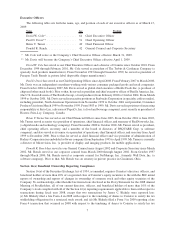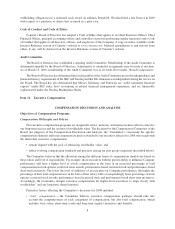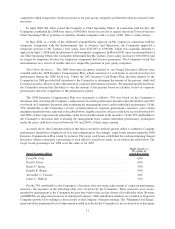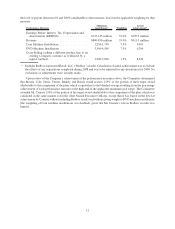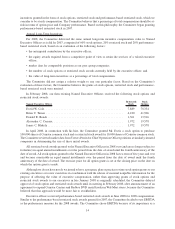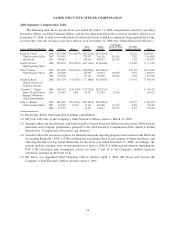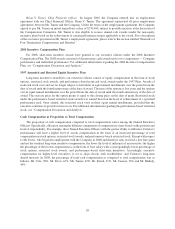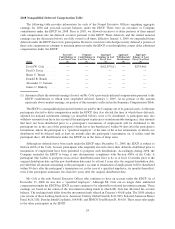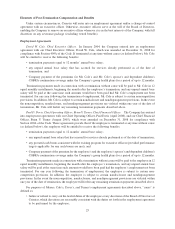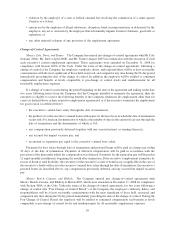Redbox 2008 Annual Report Download - page 98
Download and view the complete annual report
Please find page 98 of the 2008 Redbox annual report below. You can navigate through the pages in the report by either clicking on the pages listed below, or by using the keyword search tool below to find specific information within the annual report.Prior to 2005, we provided an opportunity for executives to defer portions of their annual cash compensation
into tax-deferred interest-bearing accounts pursuant to our Executive Deferred Compensation Plan (the “EDCP”).
Effective January 1, 2005, the Committee suspended future deferrals under this plan due to low participation.
Executives who had previously deferred a portion of their cash compensation continue to maintain interests in the
plan. These interests are shown in the 2008 Nonqualified Deferred Compensation Table in this Amendment.
Elements of Post-Termination Compensation and Benefits
Employment Agreements and Change-of-Control Agreements. We have entered into employment agree-
ments with Messrs. Cole, Davis and Turner and have entered into double-trigger change-of-control agreements with
all of our Named Executive Officers. Executive officers who do not have an employment agreement serve at the will
of the Board of Directors, thus enabling the Board to remove an executive officer whenever it is in our best interests,
with full discretion on any severance package (excluding vested benefits). The Committee believes that the
employment agreements and change-of-control agreements that have been entered into were merited in light of all
relevant circumstances, including each individual’s past employment experience, desired terms and conditions of
employment and the strategic importance of their respective positions, including stability and retention. The
Committee believes that the employment agreements were necessary in order to attract and retain the executives.
The Committee believes that the change-of-control agreements are necessary in order to retain and maintain
stability among the executive group in the event of a potential or actual change-of-control and that the terms of the
change-of-control agreements are reasonable based on its review of the change-of-control agreements for similarly
situated peer group companies. The Committee and outside consultants reviewed the agreements at the time they
were entered into in order to determine current market terms for the particular executive and agreement.
Officer Stock Ownership Guidelines
Because the Committee believes that stock ownership is an essential tool to align management and stockholder
interests, the Committee has adopted a program to require our executive officers to own prescribed amounts of Coinstar
common stock. Under this program (as revised by the Committee in April 2008), the Chief Executive Officer, Chief
Operating Officer and Chief Financial Officer must own shares of Coinstar common stock (including restricted stock,
whether or not vested) equal in value to 75% of their respective base salary. All other executive officers must own stock
equal in value to 50% of their base salary. The program was originally adopted in December 2002 and became effective
in January 2003, with a four-year phase-in period. Persons that are named as executive officers subsequent to adoption of
the program are granted a four-year grace period to meet the program requirements. Executive officers must show
progress of 25% per year until the four-year target is met. The shares owned are valued at the greater of (i) the price at the
time of purchase/acquisition or (ii) the current market value. The stock ownership guidelines are annually reviewed by
the Committee, including executive compliance with the guidelines along with any changes necessary to the guidelines.
As of December 31, 2008, each of our executive officers subject to the guidelines had met the stock ownership
requirements.
Tax Considerations
Tax Deductibility of Executive Compensation
Section 162(m) of the Code imposes a $1 million limit on the amount that a publicly traded corporation may deduct
for compensation paid to the Chief Executive Officer and the three other most highly compensated executives (other than
the Chief Financial Officer) in a fiscal year. “Performance-based compensation” is excluded from this $1 million limit.
Stock options and certain performance-based restricted stock awards granted to our executive officers pursuant to our
equity compensation plans are designed to qualify for the performance-based exemption. Restricted stock awards
granted to our executive officers have not been designed to qualify for the performance-based exemption. While the
Committee believes it is important to maximize the tax deductibility of compensation paid to our executive officers, the
Committee has not adopted a policy that all compensation must be tax-deductible and qualified under Section 162(m). In
order to maintain ongoing flexibility of our compensation programs, the Committee may from time to time approve
incentive and other compensation that exceeds the $1 million limit.
16



